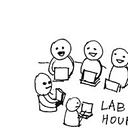by ann
Fall has finally arrived in New York City! Week 3 marked the last (hopefully) hot week of summer and cooler weather couldn’t have arrived soon enough for students.
Day 1: John Whitney and Abstract Computer Animation
Fresh off the weekend, students started the day by showing off their Vera Molnár recreations from the previous week’s homework. Niklas and Matt J. even shared a very handy, super flexible grid template inspired by Molnár, which you can download from github here.
Next, Zach Lieberman lectured about abstract computer animation, starting with the work of Mary Ellen Bute, a pioneer of abstract animation, who created a number of influential films from the 1930s-50s. The students then researched the life and work of John Whitney, who is largely thought of as the founder of computer animation.
Whitney, who was in Paris studying to become a composer when the war broke out, was inspired, along with his brother, to create experimental films after seeing the work of Oskar Fischinger. In 1942, the Whitney brothers released their first piece Variations on a Circle. In order to create the work, Whitney had constructed an animation stand, and he continued developing a mechanical pendulum device that could be calibrated to obtain certain animation sequences.
In the late 1950s, Whitney repurposed a WWII M-5 gun director for use as a drawing device. As the original machine was used to calculate mathematical firing sequences, Whitney was able to use it to perform the types of calculations that would later be used for graphics by digital computers.
In 1966, Whitney became the first artist-in-residence at IBM, and by the 1970s he had abandoned analog machines for digital drawing, which he used in films such as Arabesque (1975).
Day 2: Art, Design, and Activism
Week 2 of Morehshin Allahyari’s class was all about art activism. The class began by discussing the week’s reading, and debated the difference between art and design.
“Does an art object need to have functionality?” — Morehshin Allahyari
Then three students, April Soetarman, Fernando Ramallo, and Ying Quan Tan presented on Disobedient Objects, Ideology, Confrontation, and Awareness, and Revolutionary Futurity respectively.
April questioned the aestheticization of objects of protest, and wondered what it meant to host an exhibition of “protest art” at the upscale Victoria and Albert Museum, the self-proclaimed world’s leading museum of art and design.
Fernando asked whether artist Adrian Piper’s declaration that confronting the “sinner with the sin” and pushing people to question their belief systems by showing them their flawed thinking was naive. Especially in a world where people at times seem to be willfully ignorant, and hostile to ideological self-examination.
Ying took the class on a tour of artists that use archiving as an activist medium. He discussed artists such as Samson Young who use sound to memorialize US bombings on the Middle East, to Sheida Soleimani who uses digital archives and the viewer’s desktop as a space for exhibition, to Trevor Paglen who photographs restricted military sites that would otherwise escape the historical archive.
Day 3: Introduction to Logic Gates
Despite the sweltering heat, students fired up their soldering irons and got ready for week two of their hardware class with Taeyoon Choi.
Taeyoon kicked things off by showing the students his newly released book, the Poetic Computation Reader, which was made in collaboration with HAWRAF.
The Reader uses a custom-built platform that allows users to adjust type size, font, color, and spacing, and to read-aloud using a text-to-speech API. The project is open source for anyone who’s been looking for a better way to publish online.
Next, the students demoed the single-pull double-throw switches they had designed for the past week’s homework. Taeyoon also discussed the importance of a 0– Ground Signal, and how that differed from simply breaking out to an open circuit by cutting off power.
He then lectured on transistors and gave an introduction to logic gates.
The class quickly dove into soldering their second set of circuits: a 9V → 5V Voltage Regulator, and an AND gate.
Day 4: Ramsey Nasser and the Meaning of ‘Poetic Computation’
The final day of week 3 marked the first lecture in the Code Poetry track this fall semester with Ramsey Nasser. Nasser invited students to reflect on the meaning of ‘poetic computation’ and led a discussion on the history and precedents to modern day computer and algorithmic art.
“[Digital art] is a form of instructional art that’s made unique by the fact that the agent that interprets the instructions need not be human.” — Ramsey Nasser
He talked about music, Fluxus instructional art, and Arabic calligraphy as corollaries to today’s computer art. In each case the artist either creates or works within a set of instructions, which then gets interpreted by another person.
Though the interpreter in the case of computation isn’t human, that does not mean it is neutral. Nasser also discussed his own research and art, and his interest in the neutrality of programming. He gave as example the primacy of American English in computer programming —e.g. in C# color is sans-u — and what that means for non-native speakers: how does that change access? How does it change someone’s ability to be expressive?
“The act of naming something is a cultural act. It can even be a violent act.” — Ramsey Nasser
After the discussion, the students broke into pairs for an activity on instruction and interpretation. One student was given a drawing and acted as a “programmer” while the second student was the “computer.” The programmer would describe the drawing to the computer, who would do her best to reproduce the original picture. There was a lot that got lost in translation (or interpretation) as evidenced by the photos below.
All in all, another great week at SFPC!
